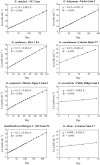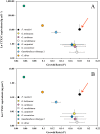Ciguatoxicity of Gambierdiscus and Fukuyoa species from the Caribbean and Gulf of Mexico
- PMID: 29045489
- PMCID: PMC5646788
- DOI: 10.1371/journal.pone.0185776
Ciguatoxicity of Gambierdiscus and Fukuyoa species from the Caribbean and Gulf of Mexico
Abstract
Dinoflagellate species belonging to the genera Gambierdiscus and Fukuyoa produce ciguatoxins (CTXs), potent neurotoxins that concentrate in fish causing ciguatera fish poisoning (CFP) in humans. While the structures and toxicities of ciguatoxins isolated from fish in the Pacific and Caribbean are known, there are few data on the variation in toxicity between and among species of Gambierdiscus and Fukuyoa. Quantifying the differences in species-specific toxicity is especially important to developing an effective cell-based risk assessment strategy for CFP. This study analyzed the ciguatoxicity of 33 strains representing seven Gambierdiscus and one Fukuyoa species using a cell based Neuro-2a cytotoxicity assay. All strains were isolated from either the Caribbean or Gulf of Mexico. The average toxicity of each species was inversely proportional to growth rate, suggesting an evolutionary trade-off between an investment in growth versus the production of defensive compounds. While there is 2- to 27-fold variation in toxicity within species, there was a 1740-fold difference between the least and most toxic species. Consequently, production of CTX or CTX-like compounds is more dependent on the species present than on the random occurrence of high or low toxicity strains. Seven of the eight species tested (G. belizeanus, G. caribaeus, G. carolinianus, G. carpenteri, Gambierdiscus ribotype 2, G. silvae and F. ruetzleri) exhibited low toxicities, ranging from 0 to 24.5 fg CTX3C equivalents cell-1, relative to G. excentricus, which had a toxicity of 469 fg CTX3C eq. cell-1. Isolates of G. excentricus from other regions have shown similarly high toxicities. If the hypothesis that G. excentricus is the primary source of ciguatoxins in the Atlantic is confirmed, it should be possible to identify areas where CFP risk is greatest by monitoring only G. excentricus abundance using species-specific molecular assays.
Conflict of interest statement
Figures




Similar articles
-
Toxicity screening of 13 Gambierdiscus strains using neuro-2a and erythrocyte lysis bioassays.Harmful Algae. 2017 Mar;63:173-183. doi: 10.1016/j.hal.2017.02.005. Epub 2017 Mar 9. Harmful Algae. 2017. PMID: 28366392
-
Morphology, toxicity and molecular characterization of Gambierdiscus spp. towards risk assessment of ciguatera in south central Cuba.Harmful Algae. 2019 Jun;86:119-127. doi: 10.1016/j.hal.2019.05.007. Epub 2019 May 31. Harmful Algae. 2019. PMID: 31358271
-
Toxicity Characterisation of Gambierdiscus Species from the Canary Islands.Toxins (Basel). 2020 Feb 21;12(2):134. doi: 10.3390/toxins12020134. Toxins (Basel). 2020. PMID: 32098095 Free PMC article.
-
Ciguatera Fish Poisoning in the Caribbean Sea and Atlantic Ocean: Reconciling the Multiplicity of Ciguatoxins and Analytical Chemistry Approach for Public Health Safety.Toxins (Basel). 2023 Jul 10;15(7):453. doi: 10.3390/toxins15070453. Toxins (Basel). 2023. PMID: 37505722 Free PMC article. Review.
-
Differential toxin profiles of ciguatoxins in marine organisms: Chemistry, fate and global distribution.Toxicon. 2018 Aug;150:124-143. doi: 10.1016/j.toxicon.2018.05.005. Epub 2018 May 17. Toxicon. 2018. PMID: 29778594 Review.
Cited by
-
Effects of substratum and depth on benthic harmful dinoflagellate assemblages.Sci Rep. 2020 Jul 9;10(1):11251. doi: 10.1038/s41598-020-68136-6. Sci Rep. 2020. PMID: 32647125 Free PMC article.
-
Ciguatera Fish Poisoning: The Risk from an Aotearoa/New Zealand Perspective.Toxins (Basel). 2020 Jan 15;12(1):50. doi: 10.3390/toxins12010050. Toxins (Basel). 2020. PMID: 31952334 Free PMC article. Review.
-
Model of the Origin of a Ciguatoxic Grouper (Plectropomus leopardus).Toxins (Basel). 2023 Mar 21;15(3):230. doi: 10.3390/toxins15030230. Toxins (Basel). 2023. PMID: 36977121 Free PMC article.
-
Pacific-Ciguatoxin-2 and Brevetoxin-1 Induce the Sensitization of Sensory Receptors Mediating Pain and Pruritus in Sensory Neurons.Mar Drugs. 2021 Jul 6;19(7):387. doi: 10.3390/md19070387. Mar Drugs. 2021. PMID: 34356812 Free PMC article.
-
Screening for Predictors of Chronic Ciguatera Poisoning: An Exploratory Analysis among Hospitalized Cases from French Polynesia.Toxins (Basel). 2021 Sep 12;13(9):646. doi: 10.3390/toxins13090646. Toxins (Basel). 2021. PMID: 34564650 Free PMC article.
References
-
- Lehane L. Ciguatera update. Med J Aust. 2000;172(4): 176–9. - PubMed
-
- Ohizumi Y, Shibata S, Tachibana K. Mode of the excitatory and inhibitory actions of ciguatoxin in the guinea-pig vas-deferens. J Pharmacol Exp Ther. 1981;217(2): 475–80. - PubMed
-
- Bidard JN, Vijverberg HPM, Frelin C, Chungue E, Legrand AM, Bagnis R, et al. Ciguatoxin is a novel type of NA+ channel toxin. J Biol Chem. 1984;259(13): 8353–7. - PubMed
-
- Benoit E, Legrand AM, Dubois JM. Effects of ciguatoxin on current and voltage clamped frog myelinated nerve-fiber. Toxicon. 1986;24(4): 357–64. doi: 10.1016/0041-0101(86)90195-9 - DOI - PubMed
MeSH terms
Substances
LinkOut - more resources
Full Text Sources
Other Literature Sources
Miscellaneous

